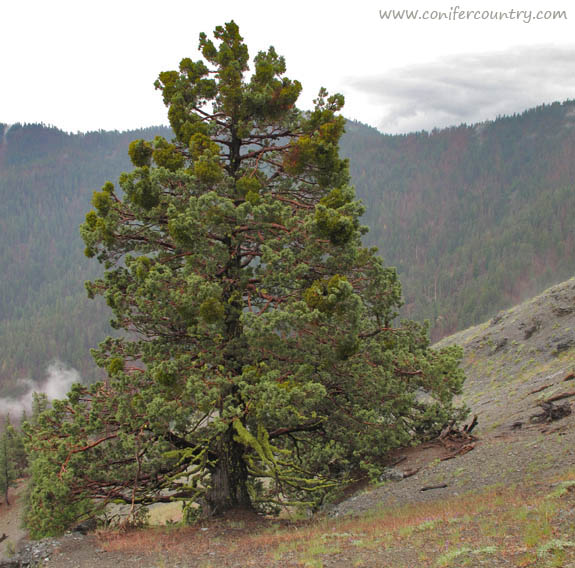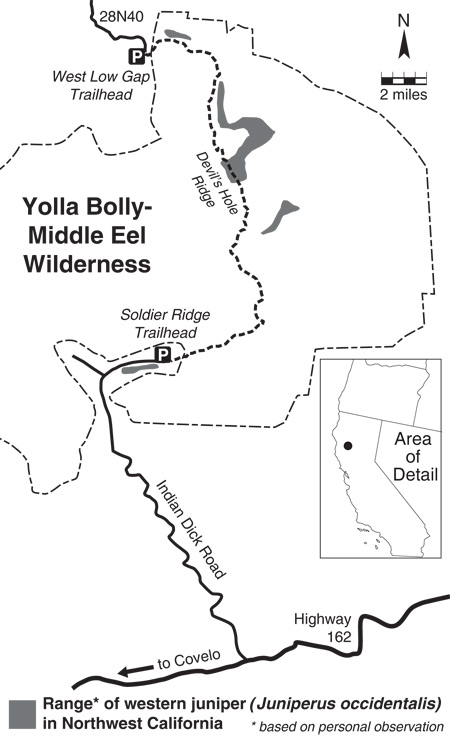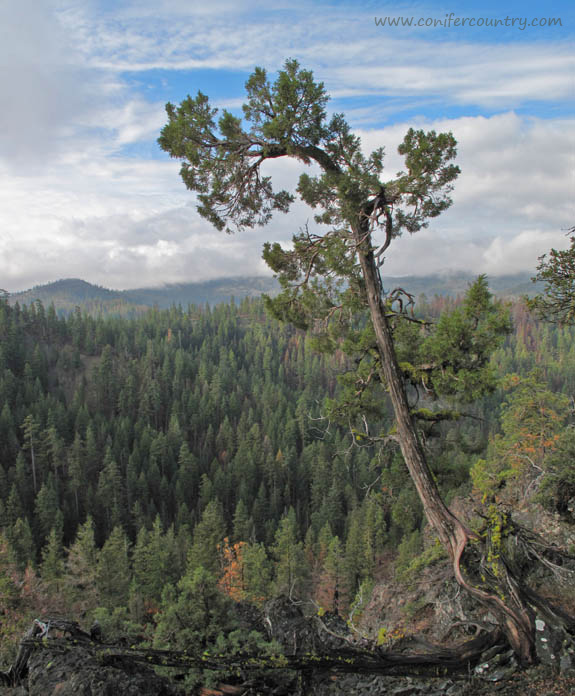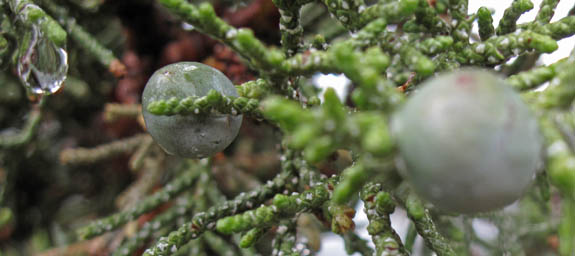Original Publication DATE: 7/29/2009
Two days into my 400 mile trek on the Bigfoot Trail I stopped to watch rain clouds clear above the headwaters of Cottonwood Creek–deep in the Yolla Bolly-Middle Eel Wilderness. As wind whipped the cool electric air past my ears a plant caught my eye–20 yards below the ridge on which I was balanced. This stately specimen had taken purchase many years ago in this rocky, windswept environment. This was a place in which only the heartiest of plants could hope to endure. Its reddish branches stood out in stark contrast to the lime green foliage. As I slowly crawled down the hillside my mind turned over and over with ideas of what species this might be. At first I believed it was cypress–possibly a MacNab or Sargent. But As I got closer I noticed the berry cones which are a diagnostic trait of junipers.

The adventurous, isolated trailhead I picked for the beginning of the Bigfoot trail was identified for the sole reason of finding Sierra junipers that Dr. John Sawyer had told me about. Soldier Ridge in the southern Yolla Bolly is known to foster a healthy and isolated population of this species. This was the only population he knew about in the Coast Range–far across the Central Valley from the potential parent population. Sierra junipers range from the central and southern Sierra Nevada south to the an Bernardino Mountains in California and east into isolated sky islands in Nevada (range map). What I was enjoying was surely one of the rarest conifers in coastal northwest California–and I also wrongly assumed what species it was. This was confusing because these plants grow here in an identical habitat to where one might find Sierra juniper in central and southern California–high on mountainous windswept ridgelines. This is an environment where competition is at a minimum with other conifers, a niche where these junipers have eked out a specialized existence different than the parent populations.

The Sierra or mountain juniper (Juniperus grandis) was recently reclassified as a new species and separated from the western juniper (Juniperus occidentalis) after extensive studies by Robert Adams–one of the world’s experts on the genus Juniperus. The two species were easily split geographically–where western juniper’s range could be defined as north of the Sierra Nevada and Sierra juniper’s range as south of the Cascades (range map). I have also listed a few non-techical distinctions below that can be seen in the field:
|
Sierra juniper (Juniperus grandis) |
western juniper (Juniperus occidentalis) |

Then there is the question of the stands of trees in the Yolla Bolly–growing equidistant from the main populations of both occidentalis and grandis. With a belief that this population was Juniperus grandis, I collected some specimens and sent them off to Robert Adams at Baylor University. He rand some tests and got back to me with some exciting news, saying:
“Hi Michael:
I just extracted the leaf oils from the 1st three samples of J. grandis you sent. The oil looks more like J. occidentalis (var. occidentalis) from Bend, OR than it does to my other J. grands oils!”
Needles to say, what was believed to be a population of Juniperus grandis for many years was proved to be Juniperus occidentalis.
In a later communication with David Charlet, a conifer expert from Nevada, he relayed to me the following:
“The Klamath Mountain area is so important to understanding conifers throughout North America. As part of a regional survey of Juniperus osteosperma/J. occidentalis genetics, I chased down a collection known from the late 1800s by Jepson “at the headwaters of the Mad River, Yolla Bolly Mts.” I found a small stand of Juniperus occidentalis in the Wilderness there and this population had 46 of the 49 alleles the genetics group was following! The largest number any other population (about 100 populations were sampled, all the way to Utah) during this study had was 24 I believe.”
For being so isolated, they had most of the genetic diversity in this study by Terry, Nowak, and Tausch. This is was quite surprising. One would think that isolated populations have less genetic diversity, even if they contain special [unique] alleles that are found only there and so contribute to the overall species genetic diversity. This information suggests, once again, that the Klamath Mountains are quite unique in the offerings of conifers and other botanical wonders–essentially a womb from which species diversity is fostered.

References:
- Technical paper by Robert Adams (2008) discussing taxonomy of junipers in the southwest.
- Treatment by Chris Earle at conifers.org
- Terry, R.G., Nowak, R. S., and Tausch, R.J., Genetic Variation in Chloroplast and Nuclear Ribosomal DNA in Utah Juniper. American Journal of Botany 87(2): 250–258. 2000
Greetings
I worked as an archaeologist for Six Rivers National Forest for over 20 years. I spent a significant amount of time working and doing research in the Yolla Bollys.
There is also a grove of aspen trees on the south facing slopes of North Yolla Bolly Peak.
As for the juniper–they are occidentalis and this is referenced in The Distribution of Trees of California Griffin and Critchfield–it is easy to Google in the internet. There are “groves” or individual trees spread across the area. I have found some in the Mad River Drainage just over the divide from the Eel and in the North Fork Eel River basin. There are a few articles on the Yolla Bolly on my web site if you are interested.
Thanks for the article!
Regards
TK
Hi Thomas- Thanks for the information. It does seem that there are quite a few groves of western juniper across that region. I here there is even one in Humboldt County near or on Eaton Roughs – ever been there? -Michael